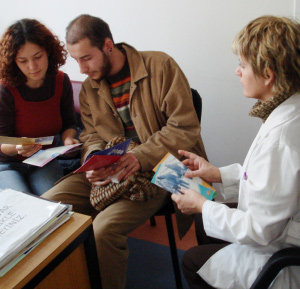Resources
An Approach to monitoring Quality of Care in Türkiye's Family Planning Programme
Resource date: 2010
Author: UNFPA
Resources
Resource date: 2010
Author: UNFPA

Türkiye used quality surveys as the main mechanism to collect data on reproductive health programmes not otherwise routinely collected or available through other means such as periodic demographic and health surveys. Data collected would guide the Ministry of Health in the management of reproductive health plans as well as international agencies supporting Türkiye's reproductive health programmes.
The surveys were intended to improve progress tracking and assess improvements in the quality of family planning services in Türkiye. It was the joint decision between the Ministry of Health and country programmes of several international agencies working in reproductive health.
STAKEHOLDERS Ministry of Health of Türkiye, USAID Türkiye, several international organizations, such as Management Sciences for Health working in Türkiye were involved.
QUESTIONS TO BE ANSWERED Eleven components of quality of care were measured
to track improvements and capture multiple dimensions of quality in family planning
service delivery.
• Adequacy of family planning unit infrastructure
• Adequacy of contraceptive storage conditions
• Availability of trained personnel
• Adequacy of infection prevention measures
• Visibility of family planning services
• Availability of modern methods
• Availability of information, education, and communication materials
• Feedback and supervision
• Use of family planning services monitoring and evaluation wall chart
• Perceived quality of family planning counselling
• Knowledge level of method users (family planning, postabortion, post-partum)
CHOOSING AND ADAPTING THE TOOL As there was a need for a low cost, rapid and practical method to measure and monitor quality on an ongoing basis, it was decided to use quick investigation of quality methodology developed by the MEASURE evaluation project of USAID.1
Once stakeholders agreed upon these eleven components of quality of care, a set of performance standards for each component was defined. Five different instruments were used to design the surveys. The standards were confined to those that could be measured through the administration of a facility checklist and client interviews.
Five different instruments were designed to collect data:
Facility checklist: designed for regular measurement of several indicators identified by the Ministry of Health, the Social Security Organization and local managers. Since it involved only a marginal increase in the cost of data collection, Management Sciences for Health encouraged counterparts to add indicators and use the results to improve services.
Exit interview questionnaires; Three types of clients were interviewed upon completion of their facility visit: family planning, postabortion, and post-partum clients. The primary purpose of the exit interviews with family planning clients was to assess the quality of counselling received. The purpose of the post-abortion and post-partum client exit interviews was to measure whether providers counsel these clients and inform them about the availability of family planning services at the facility.
Mystery client form: The purpose of the mystery or anonymous client visits was to collect data from facilities with a low volume of family planning clients as well as to validate the data collected from high volume facilities.
Because of time and resource limitations, it was decided that the Türkiye quality surveys would not involve observation as a mode of data collection. The facility audit was used to determine the readiness of each facility to serve the client. The client exit interview collected information about the client’s experience at a given health facility, providing data about the quality of services received from the client’s perspective. Since the performance standards defined for the components of quality of care did not specifically include indicators on the technical competence of providers, observation of client-provider interactions was not needed to collect data.
COST Breakdown of quality surveys’ costs
| Survey Components | Total | % |
|---|---|---|
| Preparation | $25,868.94 | 15.1% |
|
Fieldwork
|
$61,126.14 | 35.7% |
| Feedback & Reporting | $36,546.99 | 21.3% |
| Project Management costs | $47,735.75 | 27.9% |
| Grand Total | $171,277.82 | 100.0% |
| Total | |
|---|---|
| # of facilities surveyed | 830 |
| Cost per facility | $206.36 |
| Total | |
| # of clients interviewed | 12,520 |
| Cost per client | $13.68 |
| Total Contract Budget with Measure Evaluation | $259.770.00 | % |
|---|---|---|
| Total Survey Expenditures | $171,277.82 | 65.9% |
| Local Capacity Building | $55,760.00 | 21.5% |
| Other Expenses* | $19,743.68 | 7.6% |
| MSH Fee (5%) | $12,988.50 | 5.0% |
TECHNICAL ASSISTANCE Management Sciences for Health provided technical assistance for these assessments. From the start of the work the goal was to build capacity for continuing monitoring of quality, therefore training courses was designed and conducted. In this way, MSH was able to gradually shift responsibility to local managers for all phases of survey implementation, including preparation and analysis. The number of person days spent by MSH for all phases gradually decreased over the years while the Ministry of Health’s share increased.
Special efforts were made to share the results of assessment with health care providers and managers as quickly as possible. Feedback to service providers was provided within two to three months of completing data collection.
Feedback mechanisms included meetings and written reports. Provincial managers organized a series of meetings with the facilities surveyed and other stakeholders in the province to share and discuss the results. Comprehensive Powerpoint presentations of comparative facility-based feedback reports were shared with health care providers
and managers.
Sharing the results with managers and health care providers made it possible to address the problems and improve the services in collaboration with them. Building the capacity of Ministry of Health, the Social Security Organization and provincial health departments has enabled them to integrate quality improvement assessments into their routine work, and thus ensured continuity of quality assessments and improvements.
Samples of questionnaires used by this tool can be found at:
the Bank of Sample Questionnaires